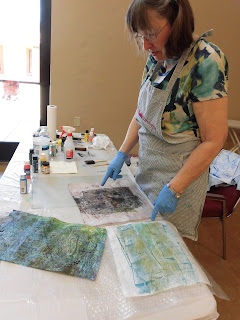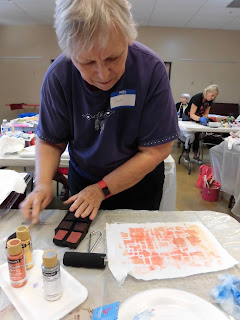 |
| A happy Marie with her monoprint! |
The first day of the workshops for the Valley Fiber Art Guild in the Green Valley area south of Tucson, Arizona, was MONOPRINTING. This is a technique that is part of the surface design portfolio and specifically uses some type of printing plate.
 |
| Combination of trace monoprinting and a brayered leaf resist (Jennifer's) |
 |
| Trace Monoprinting |
My choice of printing plate is always a plexiglass plate. Some people love gelatin plates but I find them too limiting in size and I don't care for the squishiness. I gave my gelatin plate to away to a friend, including the bottles of glycerin that I was going to use to make the glycerin/gelatin plate that keeps indefinitely at room temperature. I've collected a huge number of very different sized plexi plates so I can make both small pieces as well as huge (3' x 4') prints.
Monoprinting was new to the Valley FA Guild but they requested this part of surface design as their first workshop and were very enthusiastic about diving in and learning.
Using a firm brayer with thick textile paint (or thickened dyes) is the first requirement. (My textile paints are ProFab that come from ProChem (ProFab paints). Too thin a paint gives only a minor brayered texture. A smooth rolling motion gives an organic lined texture (like a duck or a swan taking off from a pond). If you stop in the middle you get a line----maybe what you want but maybe not.
Many techniques can be used for reductive printing (taking paint away by using something like Q-tips or a chopstick to create lines) or additive printing by adding more paint and drawings after each print. Trace monoprinting is an exciting way to create a lined drawing.
My favorite technique is to make a print (plexiglass turned onto the fabric, pressed with your hands and then lifted off), then spray the plexi plate with water, and take another print. The sprayed water liquifies the leftover paint and creates tiny dots that seem to jump off the fabric.
 |
| Marge experimenting. |
 |
| Anita used paper to do a lot of her gelatin prints. |
 |
| Ann produced a huge amount of gorgeous fabric monoprints. |
 |
| Margalis uncovering a trace monoprint. |
 |
| Assistant Peggy made a doll out of the printed fabric on the left. |
 |
| Sue used a large stamp. |
 |
| Kathe paints the back of a fig leaf to create a leaf print. |
 |
| Linda used a finely carved wood stamp to create an all-over print. |

No comments:
Post a Comment